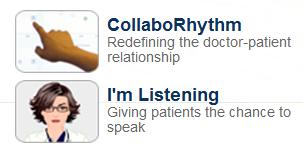Entries in Patient Engagement (42)
New Models for Leveraging Social Media for Consumer Engagement
 May 20, 2010
May 20, 2010
 Healthcare Unbound Conference Panel, San Diego, CA July 19th
Healthcare Unbound Conference Panel, San Diego, CA July 19th
Leaders in the healthcare industry are using social media in entertaining, educational and emotional ways to engage and empower the consumer.
Research has shown the cost savings resulting from consumers' use of social media to support each other. Consumers experience less depression and isolation as they navigate their own health issues. However, social media has moved beyond support to motivate consumers in new, exciting and very personal ways which will be measured through “social analytics”.
Where are we headed with social media and how are these leaders planning to get there?
During this panel, you will see and hear about examples:
- Social Media designed to attract and motivate specific consumer “segments” such as teens, seniors, caregivers, employees and patients
- Social Media intervention developed by teens for teens
- Gaming and social networks with competitions and rewards for healthy behaviors
- Differentiated “private” and “public” social media initiatives which span business goals
- New framework for generating consumer engagement incorporating financial, social and personal dimensions
Panel Moderator: Sherri Dorfman, MBA, Consumer Engagement Specialist, CEO, Stepping Stone Partners
- Paul Puopolo, Director, Consumer Innovation, Humana
- Eric Zimmerman, Chief Marketing Officer, RedBrick Health
- Rick LeMoine, MD, FACP, Chief Medical Information Officer, Sharp HealthCare
- Paul To, CEO & Founder, Emota.net
- Kendra Markle, Stanford Persuasive Technology Lab, AlterActions.org
Patients in Control Demonstrated in MIT's New Media Medicine Group
 May 11, 2010
May 11, 2010  Recently, I sat down with Dr. John Moore, Researcher in the New Media Medicine Group of the MIT Media Lab.
Recently, I sat down with Dr. John Moore, Researcher in the New Media Medicine Group of the MIT Media Lab.
“With our CollaboRhythm, we are redefining the relationship between the patient and their doctor”, explained John. “Instead of being in control, the doctor is serving as a coach to help the patient with their care planning and delivery.”
As I watched the demo, what surprised me the most was that the patient was interacting with the flat screen displaying her information and deciding about her upcoming treatment. John described what was happening. “This is ‘shared decision making’ in action where the patient determines what changes she wants to make and even schedules her medication while the doctor is by her side providing guidance as needed.”
When the patient leaves her doctor’s office, she is ready to follow through on the plans she made. “All of the follow- up information has been pushed to the electronic devices that she will rely on. Her pill dispenser has been automatically programmed. Her mobile phone is ready to receive the reminders and the necessary sensors are in place to track her activities”, John mentions with a smile.
Next, I saw a demo of the “I’m Listening” project, designed to bring the patient into her own care management process. The patient is relaxing on a coach in her living room with a cup of coffee as she is having a conversation with an “avatar” on her flat screen television. “The avatar agent asks the patient questions to gather information for her clinician. This gives the patient more freedom to share her story at her own pace”, explains John. When the patient wants to show the sore on her foot to her doctor, she lifts her foot in front of the build- in camera to have a picture taken.
I was interested to learn that this system takes all of the information gathered including the ‘words of the patient’ as well as photos and organizes it for her next doctor's appointment which she schedules. Notice the time savings for the doctor and the convenience for the patient.
With both projects, the patient has a more proactive role in managing their own health, the doctor remains in an “expert” role and their collaboration and communication are enabled through technology.
What About You?
- What are you doing to empower consumers?
- How are you engaging consumers to share their health data with you?
- Are you gathering and organizing the consumers' health information to support care decisions?
Although MIT's patient- focused products were developed in the lab, there is so much we can learn from their approach. They put the patient in control of their health with access to information and collaboration with their clinician for guidance. Technology plays an important role of seamlessly moving the patient's information to where it is needed (e.g. devices) for further interaction. During these interactions, technology enables the collection of patient data to support shared health decisions.



